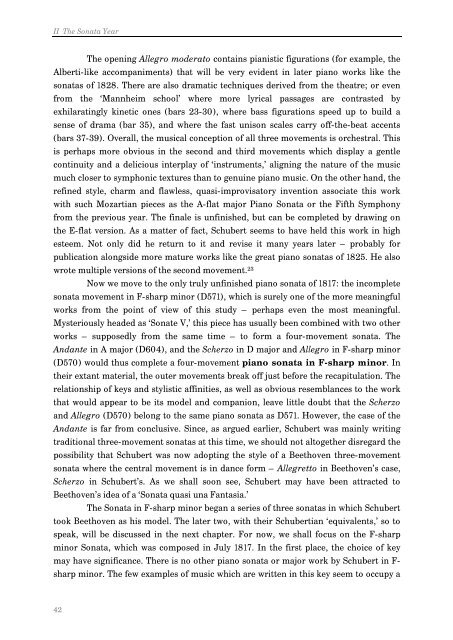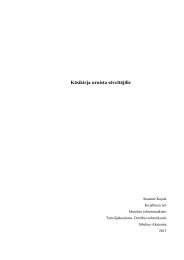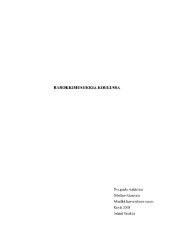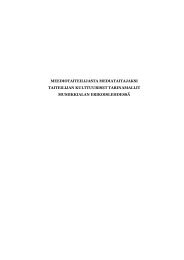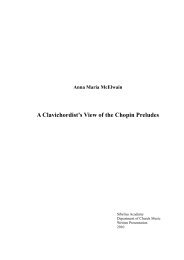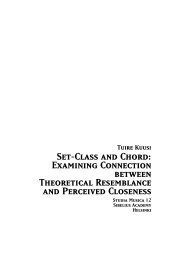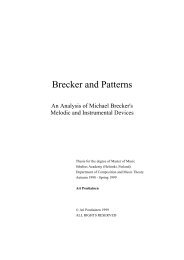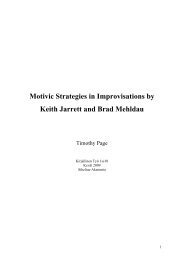The Unfinished Piano Sonatas of Franz Schubert Javier ... - Ethesis
The Unfinished Piano Sonatas of Franz Schubert Javier ... - Ethesis
The Unfinished Piano Sonatas of Franz Schubert Javier ... - Ethesis
You also want an ePaper? Increase the reach of your titles
YUMPU automatically turns print PDFs into web optimized ePapers that Google loves.
II <strong>The</strong> Sonata Year<br />
<strong>The</strong> opening Allegro moderato contains pianistic figurations (for example, the<br />
Alberti-like accompaniments) that will be very evident in later piano works like the<br />
sonatas <strong>of</strong> 1828. <strong>The</strong>re are also dramatic techniques derived from the theatre; or even<br />
from the ‘Mannheim school’ where more lyrical passages are contrasted by<br />
exhilaratingly kinetic ones (bars 23-30), where bass figurations speed up to build a<br />
sense <strong>of</strong> drama (bar 35), and where the fast unison scales carry <strong>of</strong>f-the-beat accents<br />
(bars 37-39). Overall, the musical conception <strong>of</strong> all three movements is orchestral. This<br />
is perhaps more obvious in the second and third movements which display a gentle<br />
continuity and a delicious interplay <strong>of</strong> ‘instruments,’ aligning the nature <strong>of</strong> the music<br />
much closer to symphonic textures than to genuine piano music. On the other hand, the<br />
refined style, charm and flawless, quasi-improvisatory invention associate this work<br />
with such Mozartian pieces as the A-flat major <strong>Piano</strong> Sonata or the Fifth Symphony<br />
from the previous year. <strong>The</strong> finale is unfinished, but can be completed by drawing on<br />
the E-flat version. As a matter <strong>of</strong> fact, <strong>Schubert</strong> seems to have held this work in high<br />
esteem. Not only did he return to it and revise it many years later – probably for<br />
publication alongside more mature works like the great piano sonatas <strong>of</strong> 1825. He also<br />
wrote multiple versions <strong>of</strong> the second movement. 23<br />
Now we move to the only truly unfinished piano sonata <strong>of</strong> 1817: the incomplete<br />
sonata movement in F-sharp minor (D571), which is surely one <strong>of</strong> the more meaningful<br />
works from the point <strong>of</strong> view <strong>of</strong> this study – perhaps even the most meaningful.<br />
Mysteriously headed as ‘Sonate V,’ this piece has usually been combined with two other<br />
works – supposedly from the same time – to form a four-movement sonata. <strong>The</strong><br />
Andante in A major (D604), and the Scherzo in D major and Allegro in F-sharp minor<br />
(D570) would thus complete a four-movement piano sonata in F-sharp minor. In<br />
their extant material, the outer movements break <strong>of</strong>f just before the recapitulation. <strong>The</strong><br />
relationship <strong>of</strong> keys and stylistic affinities, as well as obvious resemblances to the work<br />
that would appear to be its model and companion, leave little doubt that the Scherzo<br />
and Allegro (D570) belong to the same piano sonata as D571. However, the case <strong>of</strong> the<br />
Andante is far from conclusive. Since, as argued earlier, <strong>Schubert</strong> was mainly writing<br />
traditional three-movement sonatas at this time, we should not altogether disregard the<br />
possibility that <strong>Schubert</strong> was now adopting the style <strong>of</strong> a Beethoven three-movement<br />
sonata where the central movement is in dance form – Allegretto in Beethoven’s case,<br />
Scherzo in <strong>Schubert</strong>’s. As we shall soon see, <strong>Schubert</strong> may have been attracted to<br />
Beethoven’s idea <strong>of</strong> a ‘Sonata quasi una Fantasia.’<br />
<strong>The</strong> Sonata in F-sharp minor began a series <strong>of</strong> three sonatas in which <strong>Schubert</strong><br />
took Beethoven as his model. <strong>The</strong> later two, with their <strong>Schubert</strong>ian ‘equivalents,’ so to<br />
speak, will be discussed in the next chapter. For now, we shall focus on the F-sharp<br />
minor Sonata, which was composed in July 1817. In the first place, the choice <strong>of</strong> key<br />
may have significance. <strong>The</strong>re is no other piano sonata or major work by <strong>Schubert</strong> in Fsharp<br />
minor. <strong>The</strong> few examples <strong>of</strong> music which are written in this key seem to occupy a<br />
42


